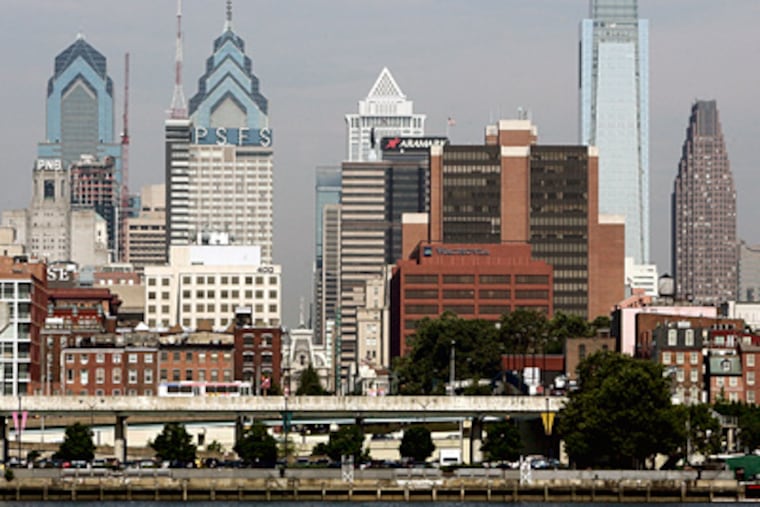Home ownership declines in Philadelphia
The percentage of Philadelphians who rent rather than own their homes rose from 40.7 percent to 45.9 percent between 2000 and 2010, one of the largest such increases among the country's biggest cities, according to U.S. Census data.

The percentage of Philadelphians who rent rather than own their homes rose from 40.7 percent to 45.9 percent between 2000 and 2010, one of the largest such increases among the country's biggest cities, according to U.S. Census data.
Factor the recession and the housing industry's nosedive into this statistic, of course. But the primary reason for the jump can be summed up in two words: Center City.
Since 1997, almost 13,000 units - primarily condos and apartments - have been built or rehabilitated downtown and in adjacent neighborhoods, the Center City District reports.
And since 2000, the district's numbers show, the population of Philadelphia's expanding core has climbed to 93,000, from 78,900.
Thirty percent of those residents fall into 25-to-34 age group. The median age of U.S. home buyers is 39, the National Association of Realtors says.
Empty nesters from the suburbs also have been part of the movement to the city, and large numbers of them rent initially.
"The increase in both population and our housing stock - both of which are disproportionately located in Center City - are the underlying reasons behind this rise in the rental rate," said economist Kevin Gillen, vice president of Econsult Corp. "Much of the population growth has come from young households, which are more inclined to rent."
In the five decades preceding 2000, there was little residential construction in and around Center City. That changed in the late 1990s, when City Council passed tax-abatement laws for new and rehabbed buildings.
Apartment construction and renovation peaked in 2002, at the start of the for-sale housing boom. By then, Center City had 23,000 apartments.
Beginning in 2003, many buildings launched as rental apartments converted to for-sale condos, and fewer rental units were built.
Locally, the real estate boom ended in 2007.
"The increase in the housing stock that occurred just as the market turned led many condo owners to sublet units as rentals," Gillen said.
Last year, 161 rental units came on the market, almost three times the number of condos built for sale, and the total number of Center City apartments rose to 39,000.
"There has been a significant growth in renters in Center City as younger people remain for work and other people relocate here," said Center City District president Paul Levy.
There are at least four sources of rental demand, Levy said: newly forming households; college and graduate students; young people staying after college or coming for jobs; and potential buyers who have decided to wait and rent.
"All four have caused rents to go up even as supply has increased," he said, "so this type of growth is good for the downtown."
The expansion of health-care and education employment has been a boon to the Center City rental market as well as the economy there, which Levy said had remained "remarkably stable," partly because 42 percent of residents work downtown as well as live there.
The population is well-educated, and the "income of these high-wage earners not only sustains housing values but contributes to the stability of the downtown retail market," Levy said.
Because the focus of residential construction during the boom times was on for-sale housing rather than rentals, there aren't enough high-end apartments to go around now.
"We are finding the high-end rentals to be almost nonexistent, as they rent fairly quickly," said real estate agent Mark Wade, of Prudential Fox & Roach.
Condos near the University of Pennsylvania and Thomas Jefferson University "have a built-in demand for rentals, and we have seen that equation play out year after year," Wade said.
The most recent data from the Center City District show rents for one-bedroom apartments averaging $1,342 a month, $1,823 for a two-bedroom - about the same as in 2009. Ten years ago, a one-bedroom averaged about $962 and a two-bedroom about $1,300.
Many renters want to buy, but fewer are doing so. Financing for purchases remain tight, especially for younger people who lack up-front cash for down payments and strong credit scores.
Hampering those with homes to sell already, prices continue to fall in many major U.S. metropolitan areas, as reflected in Tuesday's S&P Case-Shiller Home Price Indexes.
Developers who cannot sell their units are often prevented by their lenders from renting them, Wade said, so some may offer lease-purchase agreements that allow renters to buy their units at some point in the future.
What strikes Moody's Analytics economist Mark Zandi is how high the city's homeownership rate - 54.1 percent - remains compared with comparable cities in the Northeastern United States and elsewhere.
"High home-ownership is one of the economic strengths and charms of Philadelphia," he said.